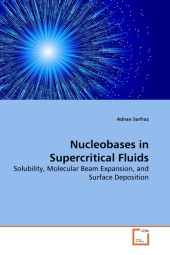 Neuerscheinungen 2010Stand: 2020-01-07 |
Schnellsuche
ISBN/Stichwort/Autor
|
Herderstraße 10
10625 Berlin
Tel.: 030 315 714 16
Fax 030 315 714 14
info@buchspektrum.de |

Adnan Sarfraz
Nucleobases in Supercritical Fluids
Solubility, Molecular Beam Expansion, and Surface Deposition
2010. 112 S.
Verlag/Jahr: VDM VERLAG DR. MÜLLER 2010
ISBN: 3-639-18237-5 (3639182375)
Neue ISBN: 978-3-639-18237-8 (9783639182378)
Preis und Lieferzeit: Bitte klicken
Supercritical fluids have found applications in a wide variety of fields, from solvents for reaction media to engineering of nanoparticles. They are also of interest in the analytical field for transferring non-volatile organic molecules into the gas phase for detection and deposition purposes. This book highlights the use of supercritical fluids as an analytical tool for the transfer of a group of non-volatile molecules, namely nucleobases, into the gas phase. Moreover, a new bracketing method is described for detecting the critical point of pure fluids and diluted mixtures of fluids. Five biologically relevant nucleobases i.e. adenine, guanine, cytosine, thymine and uracil were dissolved in supercritical ethylene and detected in the gas phase using molecular beam expansion mass spectrometry. Surface deposition of the nucleobases through rapid expansion of supercritical fluids (RESS) showed remarkable differences while comparing the morphology obtained after deposition using drop casting method. These differences are discussed in terms of diffusion, rate of evaporation of the solvent, degree of supersaturation, and the nucleation process.
Dr. rer. nat. Adnan Sarfraz completed his M.Sc. and M.Phil. in Physical Chemistry from Quaid-i-Azam University, Islamabad, Pakistan with a chancellors medal for outstanding academic achievement. He then completed his Ph.D. in Physical Chemistry from Humboldt University (HU), Berlin in 2009. This book is based on research conducted at HU Berlin.


